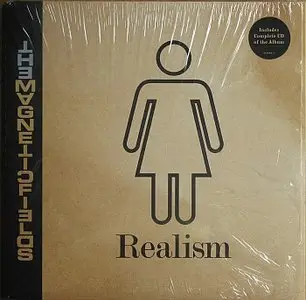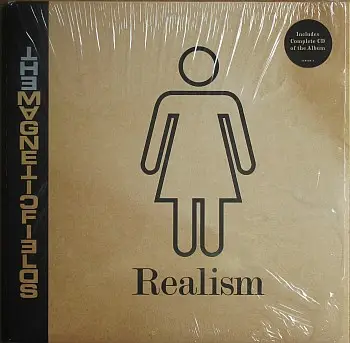The Magnetic Fields - Realism (2010) - VINYL
Vinyl rip in 24-bit/96kHz | FLAC (5% Recovery) | m3u's, md5 checksum, no cue or log (vinyl) | RS + HotFile
650 MB (24/96) or 200 MB redbook | Artwork | Rock | 2010
Vinyl rip in 24-bit/96kHz | FLAC (5% Recovery) | m3u's, md5 checksum, no cue or log (vinyl) | RS + HotFile
650 MB (24/96) or 200 MB redbook | Artwork | Rock | 2010
Described by songwriter Stephin Merritt as "my folk album", the instrumentation of Realism is largely acoustic, stark in contrast to the band's previous album, Distortion, released in 2008. Merritt said he "thought of the two records as a pair" and considered titling the albums True and False; ultimately, he couldn't decide which title would correspond with which album.
Details
––––––––––––––––––––-
Released January 26, 2010
Recorded Mother West, New York
Genre Indie pop, folk-pop
Length 35:17
Label Nonesuch
Producer Stephin Merritt
Provided to me by a friend.
Track List
–––––––––––––––––––––
1. You Must Be Out Of Your Mind 3:14
2. Interlude 2:13
3. We Are Having A Hootenanny 2:12
4. I Don't Know What To Say 2:31
5. The Dolls' Tea Party 2:19
6. Everything Is One Big Christmas Tree 2:26
7. Walk A Lonely Road 3:06
8. Always Already Gone 2:42
9. Seduced And Abandoned 2:23
10. Better Things 2:33
11. Painted Flower 2:13
12. The Dada Polka 2:23
13. From A Sinking Boat 3:27
Bios (allmusic.com)
–––––––––––––––––––––
The Magnetic Fields may be a bona fide band, but in most essential respects they are the project of studio wunderkind Stephin Merritt, who writes, produces, and (generally) sings all of the material. Merritt also plays many of the instruments, concocting a sort of indie pop synth rock. While the Magnetic Fields' albums draw upon the electronic textures of vintage acts like ABBA, Kraftwerk, Roxy Music with Eno, Joy Division, and Gary Numan, Merritt's vision is far more pointed toward the alternative rock underground. His songs are also far warmer and more purely pop-oriented than the above references indicate, sounding at times like late-20th century equivalents to the catalogs of Phil Spector or Brian Wilson.
Merritt began recording music on his own four-track at a young age, but he didn't issue the first Magnetic Fields album until 1990, when he was well into his twenties. The first pair of discs featured the choirgirl vocals of Susan Amway, but Merritt handled the vocals himself on most subsequent releases, singing in a deep croon not far removed from his European influences. The synth pop quotient also became heavier on those albums, although Merritt always took care to mix in quite a few natural instruments with the electronic ones, often with the help of Claudia Gonson (percussion) and Sam Davol (cello, flute). Throughout it all, an emphasis remained on the band's pop hooks and eccentric, romantically reflective lyrics rather than the bedrock synthetic rhythms and textures.
In addition to his work with Magnetic Fields, Merritt involved himself in several side projects over the years, the most notable being the 6ths' Wasps' Nests album in 1995. Merritt sang only one track himself on this disc, for which he acted as composer/producer/multi-instrumentalist, employing well-known alternative rock singers like Barbara Manning, Dean Wareham (Luna), Lou Barlow, Georgia Hubley (Yo La Tengo), Chris Knox, and Robert Scott (the Bats) to handle the lead vocals. After releasing 1997's New Despair as the Gothic Archies, Merritt finally returned to the Magnetic Fields aegis for 1999's 69 Love Songs, released as both a trio of separate discs as well as a limited edition three-CD box set. Merritt spent the next few years releasing more side projects, including records from the Gothic Archies, Future Bible Heroes, the 6ths, as well as numerous soundtracks. It wasn't until May 2004 that Merritt and his Magnetic Fields finally got around to making i, a collection of songs that begin with the aforementioned vowel. Distortion followed in early 2008; shortly thereafter, Merritt set to work on an acoustic folk-influenced album, Realism, which was released in January 2010.
Wiki Info ( http://en.wikipedia.org/wiki/Realism_%28The_Magnetic_Fields_album%29 )
–––––––––––––––––––––
Realism is an album by The Magnetic Fields. It was officially released on January 26, 2010 by Nonesuch Records.
Described by songwriter Stephin Merritt as "my folk album", the instrumentation of Realism is largely acoustic, stark in contrast to the band's previous album, Distortion, released in 2008. Merritt said he "thought of the two records as a pair" and considered titling the albums True and False; ultimately, he couldn't decide which title would correspond with which album. The song "The Dada Polka" is the only track to utilize an electric guitar. Merritt also avoided using a traditional drum kit, further separating the sound of Realism from the noise pop of Distortion. Along with Distortion and the 2004 album i, Realism was also recorded without the use of synthesizers, completing the band's "no-synth trilogy".[1][2]
Joshua Rifkin, who arranged the Judy Collins albums In My Life and Wildflowers, was cited by Merritt as a creative influence for Realism.
Youtube Links
–––––––––––––––––––––
You Must Be Out Of Your Mind http://www.youtube.com/watch?v=77gy-2UUA-c
Everything Is One Big Christmas Tree http://www.youtube.com/watch?v=8R9QTv6rngc
Walk A Lonely Road http://www.youtube.com/watch?v=ZssvMk4SixU
From A Sinking Boat http://www.youtube.com/watch?v=now3r0KQKz0
Review ( http://allmusic.com/cg/amg.dll?p=amg&sql=10:aifwxz9sldse~T1 )
–––––––––––––––––––––-
http://upload.wikimedia.org/wikipedia/commons/thumb/5/51/Star_full.svg/11px-Star_full.svg.png
http://upload.wikimedia.org/wikipedia/commons/thumb/5/51/Star_full.svg/11px-Star_full.svg.png
http://upload.wikimedia.org/wikipedia/commons/thumb/5/51/Star_full.svg/11px-Star_full.svg.png
http://upload.wikimedia.org/wikipedia/commons/thumb/8/81/Star_half.svg/11px-Star_half.svg.png
http://upload.wikimedia.org/wikipedia/commons/thumb/4/49/Star_empty.svg/11px-Star_empty.svg.png
All it takes is a few seconds into Realism’s familiar first track (the warm, wily, and weary "You Must Be out of Your Mind") to jump to the conclusion that Magnetic Fields mastermind Stephin Merritt has simply run out of musical motifs with which to embed his seemingly endless supply of biting, bittersweet lyrics. Happily, that’s not the case, as the remaining 12 songs on Realism show significant musical growth for one of pop music’s greatest corner bar-, heartbreak-, and sarcasm-obsessed napkin poets. The antithesis of 2008’s noisy Distortion, Realism revels in folk music in a way that hasn’t appeared on a Magnetic Fields album since 1990’s Distant Plastic Trees. The songs sound just like their titles would suggest, with "We Are Having a Hootenanny" doing just that, "The Doll’s Tea Party" conjuring up images of pastoral English gardens, and "Seduced and Abandoned" suggesting the wee hours of a Tin Pan Alley cabaret. Merritt, who wields a voice that has grown from that of a disheartened, mumbling wallflower to a classy, full-throated baritone, peppers each tune (as well as those sung by the lovely Claudia Gonson) with the usual witticisms (“I want you crawling back to me/Down on your knees/Like an appendectomy”), but there’s an elegance to his prose this time around that suggests there's not only a musical sea change at work. By far his most listenable and fully realized work since 1999’s mammoth 69 Love Songs, Realism feels slight because it is. It’s hard to hear someone so adept with a poison pen preen instead of brood, but it’s also rewarding. In the end, longtime fans will want to go back to the opening cut and seek out the comfort of those familiar first three chords that, like a seasoned bluesman with his E to A to B, have become synonymous with their creator, but hopefully, they’ll decide to take another trip through the countryside, soak in some much needed sun, and let bygones be bygones.
Comments
–––––––––––––––––––––-
Much better dynamics than the CD. The Dynamic Range meter gives the LP a 10 and the CD only a 6.
Very few fades as the vinyl was very quiet, and I was able to cut on zero crossings quite easily.
No music was harmed in the making of this vinyl rip.
This is what I do in general. Not every step is done for all rips:
LP > Rega P1 with Ortofon Super 30 > TC-750LC > E-Mu 0202 > Adobe Audition 3 (AA) @ 96kHz 32bit float > Manual click removal in AA > Click Repair set @ 20 > AA used to balance L/R > (for MONO: Equalizer (from the ClickRepair guy) used to combine L+R >) AA to split tracks, fade in/out, and for manual click removal >
for 24bit: use AA to truncate the 32bit file >
for 16bit: Izoptope RX Advanced to resample the 32bit file to 44.1kHz > and then to dither to`16bit using MBIT+ >
All > Trader's Little Helper to FLAC and (for 16bit: sector align if necessary, pad) > MP3 Tagger to edit tags.
"16bit" = 16bit at 44.1kHz
"24bit" = 24bit at 96kHz
Rapid Share Links
Magnetic Fields - Realism
Hot File Links
Magnetic Fields - Realism
Please no mirrors and/or direct links in your comments !!
Also, if you need to reach me if something ain't working, a PM is best.
Please leave comments! I read them.
Where are you in your Tony search? A newbie? A long-timer? I'd like to hear.
Magnetic Fields - Realism
Hot File Links
Magnetic Fields - Realism
Please no mirrors and/or direct links in your comments !!
Also, if you need to reach me if something ain't working, a PM is best.
Please leave comments! I read them.
Where are you in your Tony search? A newbie? A long-timer? I'd like to hear.
Satisfy all your Tony Bennett – and The Blasters – vinyl needs on my Music Blog



